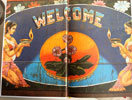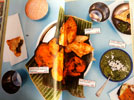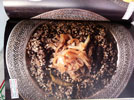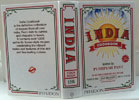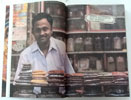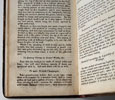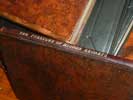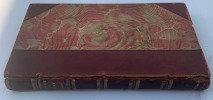The Complete Confectioner
The COMPLETE CONFECTIONER; or the Whole ART of CONFECTIONARY: Forming a Ready Assistant to all Genteel FAMILIES; giving them a PERFECT KNOWLEDGE of CONFECTIONARY: with INSTRUCTIONS, NEATLY ENGRAVED ON TEN COPPER-PLATES, How to decorate a TABLE with TASTE and ELEGANCE, Without the Expence or Assistance of a Confectioner. By a Person, Late an Apprentice to the well known Messrs. Negri and Witten, of Berkley Square. London: Printed for the Author; and sold by J. Mathews, No. 18, Strand, MDCCLXXXIX. Price 10s 6d. neatly bound. Entered at Stationers Hall. (Nutt's name did not appear on the title page until the 3rd edition of 1806)
FIRST EDITION. 8vo. Pp. Half title. Title page [v-xxiv] [1] 2-212 Illustrations: Ten numbered engraved plates, consisting of six of table settings plus three folding. Plate number 10 - a pastry molding tool, bound in separately between pages 8 & 9. A very clean copy with minimal stains. Fully bound in dark brown calf, re-backed, raised bands with blind tooling , red label with gilt lettering. Contemporary boards slightly bumped with nice polished patina. A rare item.
- Although Nutt did not add his name to the 'Complete Confectioner', it is understood that it was out of respect for another famous confectioner, Domenico Negri, at the 'Pot and Pneapple' shop in Berkley Square, where Nutt had been formally apprenticed. This probably means that many of the recipes contained in the Complete Confectioner are from the 'Pot and Pineapple' as well as his other places of employment. All conscientious apprentices would keep a journal of all recipes seen and done, as they went about learning their trade. This can be seen in the original Frederick Nutt manuscript (see item #10908 above). Approximately a total of a third of the recipes in the manuscript match all the recipes in this first edition. The eminent cookery book dealer, Janet Clarke, informs us in her catalogue online, a very interesting little snippet about Nutt the professional confectioner and his book. To quote; "The author was obviously highly proficient in his art and his recipes are meticulous and was, at one time, offered £1000 to withdraw his work from the public in order to protect his fellow confectioners who were fearful of losing business to those who might rival them having learned their art through this work". He obviously declined the offer. One wonders in what regard Nutt's fellow professionals held him after that. This also was the first book of confectionery to be published in America in 1807, for Richard Scott and sold at his Bookstore, 243 Pearl St. NY. Re-printed from the 4th English edition, with large additions.


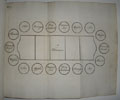

click on image to enlarge

Antiquarian category
ref number:
10909 











